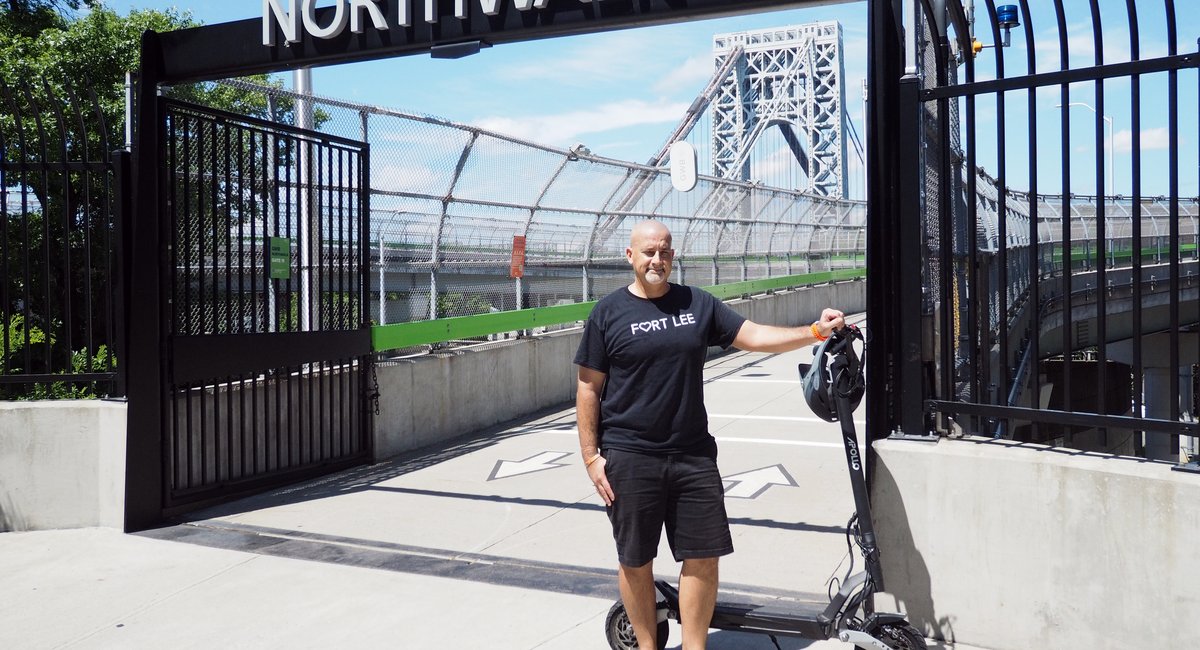A group mostly made up of New Jersey residents is having trouble bridging the gaps between different — and sometimes contradictory — explanations for why the Port Authority of New York and New Jersey says bicyclists and pedestrians can’t access the George Washington Bridge overnight.
Night owl Kacy Knight lives in Fort Lee, New Jersey, and said he longs to hop on his electric scooter for the 15-minute trek across the Hudson River after dark to experience the city’s taco trucks and late-night diners. But he can’t, because of the giant iron gates blocking the bridge’s bike and pedestrian path that close every night at midnight.
“I’d love being able to get the best ethnic food you’re not going to find in Fort Lee,” Knight said. “I can go anywhere in the city … if I can just get across the bridge.”
Knight is leading a petition to change this, which has garnered more than 100 signatures so far. It says that having 24/7 access to the bike path would be safer, healthier and promote a sustainable transportation network.
The Port Authority, which owns and operates the bridge, has given multiple reasons for why the pathway is closed for bikes and pedestrians from midnight to 6 a.m. The practice has been routine since at least 1995, the agency said. It has also said the closure was for “cleaning and maintenance” and has cited a “major restoration project” started in 2016.
Knight called the conflicting responses “unbelievable.”
“There’s no way it takes six hours to clean the bridge’s walkway,” he said. “It’s just complete nonsense and just an excuse and a lie.”
The George Washington Bridge’s 14 lanes are usually open 24 hours a day for cars, trucks and buses. The bridge, which opened in 1931, is one of the world’s busiest roadways and serves about 4 million vehicles a month, according to the Port Authority. By comparison, the agency said fewer than 90,000 pedestrians and cyclists cross the bridge in an average warm-weather month.
Yet unlike bridges maintained by the MTA and New York City’s Department of Transportation, the George Washington Bridge can’t be crossed after midnight without a car.
“Some people commute on their bicycles because they choose to,” Knight said. “But there are a lot of people who just simply can’t afford to drive a vehicle or to take an Uber into the city to work, and a lot of these people start at 5 o’clock in the morning.”
Spiro Kokkosis, a Fort Lee resident who signed the petition and owns three cafes in Midtown, said his morning crews struggle to make their shifts on time because of the bike path closure.
“They can’t get there at 6 o’clock if they’re not using a car, which is not reasonable,” he said in a phone interview. “The fact that you can’t get over the bridge until after 6 o’clock is kind of crazy to me.”
In response to questions about why the bridge routinely closes to bikes and pedestrians at midnight, Port Authority spokesperson Seth Stein emailed a two-sentence statement partly blaming the closure on a restoration project started in 2016 to rehabilitate the bridge’s cables, onramps and steel structure.
“We are currently undertaking a $2 billion restoration of the George Washington Bridge, during which time overnight closures are necessary,” Stein wrote.
That would contradict the agency’s previous assertion that the pathway has been closed overnight since 1995.
When asked for clarification, Stein said the agency “looks forward to continuing the conversation about overnight closures” when the restoration is complete, which is slated for 2030. He also said the closure allows for “essential maintenance and cleaning operations while keeping people safe on the bridge.”
When pressed, the Port Authority said a specialized machine is used to clean the walkway and takes up the entire width of the path. The agency said the machine cleans stickers and graffiti, but declined to offer further details about the equipment, including its manufacturer, cost or cleaning schedule.
Stein’s statement did not mention specific security concerns, such as the threat of terrorism. Michael Degidio, who directed security operations for the Port Authority from 2014 to 2021, told Gothamist that the agency does routine threat assessments, and these in part closed the George Washington Bridge walkway — but he declined to divulge more.
“The use of the path was considered for security considerations,” said Degidio. “I’m not saying that is the absolute reason that it’s not open or anything like that.”
During Gothamist’s interview with Knight near the bridge’s bike path, two Port Authority police officers arrived to investigate. They said Knight and a reporter were observed on a security camera and requested identification. Neither of the officers were familiar with the cleaning machine that the Port Authority said necessitates the bike path’s closure.
Benjamin Allison, who wrote a paper for the International Centre for Counter-Terrorism think tank entitled “Deadly Detours: Why Terrorists Do Not Attack US Bridges and Tunnels,” said that targeting the George Washington Bridge would be expensive.
“The thing is made out of concrete, steel, rebar and God knows what else, so I think the likelihood of it is pretty low,” he said. “It’s not like you can carry a bomb of that size on a bike.”
The Port Authority declined to answer questions about potential security threats to the bridge, or acknowledge them as a reason for the closure.
“If they just said, ‘Look, we don’t have the money for police,’ or if they gave something that seemed more viable … it’s just worse when they’re dishonest,” Knight said.
